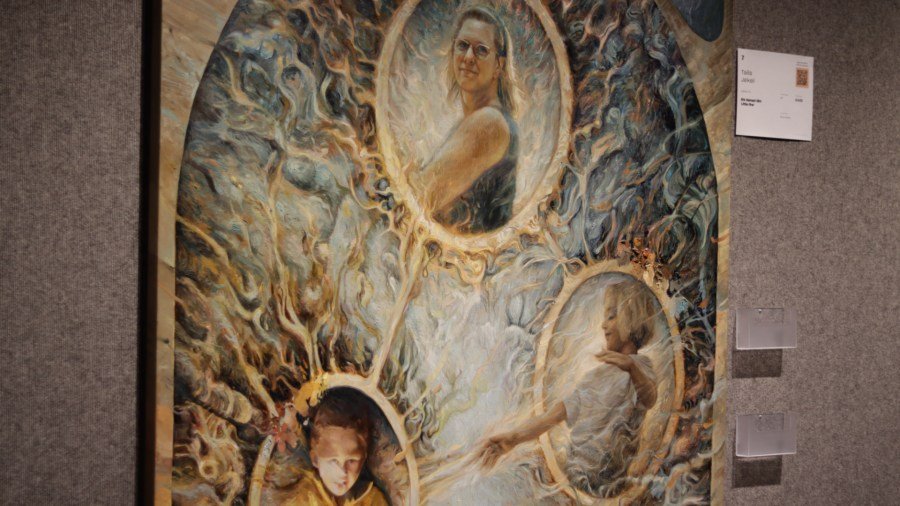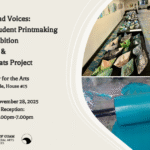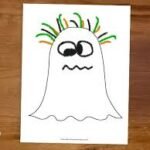
If you or someone you know is struggling, help is available by calling the 24/7 Suicide and Crisis Lifeline at 988.
GRAND RAPIDS, Mich. (WOOD) — On their 21st birthday, Holland-based artist Tails Jekel woke up to an unexpected email.
“It opened up with the line: ‘Yesterday, my little brother broke into my mom’s house and murdered her,’” Jekel recounted.
The sender was Allyson White, whose mother, 55-year-old Gloria White, was killed in her Sister Lakes-area home on Oct. 31, 2024. Gloria’s son, 23-year-old Aidan White, was taken into custody and charged in his mother’s death. He was later ruled not guilty by reason of insanity. His family told News 8 that he had undiagnosed schizophrenia, including severe hallucinations and delusions — but time and time again, pleas for help went ignored.

“She Named Him ‘Little Fire’” by Tails Jekel. (Sept. 17, 2025)
In the wake of their mother’s death, Allyson White reached out to Jekel. Ultimately, the artist spent months on end working on a painting that is now being shown at the Gerald R. Ford Presidential Museum for ArtPrize.
“I don’t know. I just knew that something had to come of all this and that people had to know what happened,” Allyson White told News 8. “It had to matter.”
THE TASK
When White first contacted Jekel, the two had never met one another.
“One of my mom and my last conversations was actually about Tails. My mom was an elementary school art teacher, so she was looking for local artists to help inspire her students that great art could come from anywhere,” White said. “And I was like, ‘I know of someone.’”
Jekel has built a sizable social media presence, with hundreds of thousands of followers on Instagram, TikTok and YouTube.
“At that point, I just figured, what did I have to lose?” White recounted.
White, who uses they/them pronouns, asked the artist to embark upon a project in the wake of their mother’s death.
“I told them what happened and a little bit about my mom and who she was, and a little bit about my brother and who he was before all of this — so, like, my memory of him,” White said. “And just that they were connected forever in these really scary, personal ways. It was just the kind of story that needed art to tell it.”
“I woke up and I read this message, and obviously it was very powerful,” Jekel, who also uses they/them pronouns, told News 8. “I truly didn’t know what to do.”
At first, the artist hesitated.
“I didn’t know Gloria before I entered this project. If I were to accept this project, I knew that my life and my art would enter the lives of a lot of people who knew and loved Gloria,” they said. “And that is a very precious thing that I knew I couldn’t mess up.”
Even knowing it was a weighty task, Jekel decided to accept.
“Oftentimes, my artwork centers around myself and my feelings and the things that I’m going through. So to now be tasked with memorializing someone that I’ve never met — it is just like a very emotionally difficult process,” they explained. “Theoretically, I could have accepted this project and tried not to process anything. You know: ‘I’m tasked with creating an image so I’m going to not think about how gruesome this is or how sad this is or how real the grief is.’ And I would have been able to create a pretty good painting, in my opinion. But that would be such a disservice to what has been trusted to me.”

Tails Jekel works on a painting of Gloria, Aidan and Allyson White. (Courtesy Tails Jekel)
In the painting, Jekel said they were given two tasks: “to memorialize Gloria and protest the systems that failed Aidan.”
‘TO MEMORIALIZE GLORIA’
“I’m not the kind of person that likes to overglorify people because they died,” Allyson White told News 8. “Because (Gloria) was so wonderfully and truly human in all of the flaws and everything, but in the most normal ways possible. Because she was a wonderful person.”

Gloria White as depicted by Tails Jekel. (Sept. 17, 2025)
Gloria taught art to elementary schoolers. She was always destined to be a teacher, Allyson White said.
“Her, I think, high school algebra teacher prophetically and hilariously said that when she grew up, she was either going to be an elementary school teacher or Minnie Mouse in Disney World,” they said. “Her personality was very much both.”
Gloria was uniquely curious.
“Living in the world without her has made me realize how unique of a person she actually was — the fact that she approached everything with curiosity and wanting to know about it,” White said. “A lot of people exist within just their worldview, and they approach all of the world through just the way that they’ve decided to see the world. My mom didn’t really do that. She just loved people and wanted to learn about everyone and ask questions.”
And she was creative, always adopting new projects and pursuing new interests.
“She had many interests in her life. She’d get on, like, special hyperfixations. But glasswork was something that she loved forever,” White recalled.
At the end of her life, Gloria was taking glassblowing classes and had recently made a glass pumpkin.
“I mean, honestly, she wasn’t very good because she was still learning,” White said, laughing. “She was very early on in the process of exploring that … so there’s a lot of globs of glass around her house.”
Gloria especially loved beach glass. She would walk along the beach with her family in search of it.
“Looking for beach glass and crinoids, like Indian beads, was a really, really big thing for us and for her. And there are bottles and bottles of beach glass that she collected throughout her life,” White said. “And she especially loved blue glass. That was her absolute favorite. And she called them ‘God winks.’ Any time she found blue glass, because it was a little bit rarer, she said it was a ‘God wink’ that let you know there was someone watching out for you. … It was just her thing.”
The motif of beach glass is present throughout Jekel’s painting. The artist never had the opportunity to meet Gloria while she was alive, so in preparation for the project, they pored over Gloria’s belongings and even got the chance to visit her home.
“Allyson had set out two stacks of scrapbooks, about a foot and a half high each. They were almost toppling over,” the artist said. “When I was looking through these books, it was the first time that I had felt very close to Gloria. I was looking at her craftsmanship. I saw the stickers that she had put in that book. I saw the words that she had written about her children when they were toddlers. I saw her hair sticking to the glue in the pages.”
It was incredibly clear, Jekel said, that Gloria loved her kids.
“She had created these books, perhaps a bit for herself, for her own meditation, but also to one day give to them,” they said.
One scrapbook included a two-page spread entitled “Aidan’s first boo-boo.”
“It was six pictures of him with a little Band-Aid wrapped around his finger,” Jekel said. “Gloria so badly did not want to see her children hurt — for her to inevitably be hurt by them as far as one could be hurt.”
‘TO PROTEST THE SYSTEMS THAT FAILED AIDAN’
Allyson White remembers their brother as a curious, loving child.

A young Aidan White as depicted by Tails Jekel. (Sept. 17, 2025)
“It’s weird because (Aidan) is still alive, but like, I don’t know what he is like now. So much of him was lost to his illness, essentially. Illness is like that. When it progresses to a certain point, you kind of just lose your sense of self. And he got so sick,” they said. “But before that, he was the class clown.”
He was funny, they said, and full of love.
“He loved our mom — I mean, he was actually mocked for it, far too much,” White recalled. “And he had a pet cockatiel that he would just sit in his room with and sing to.”
Nonprofit offers training on how to talk about suicide
As a kid, Aidan was also anxious on others’ behalf.
“He wanted everyone to be happy. He wanted to encourage everyone,” White said. “I mean, there’s stories of old childhood journals from when he was like 7: ‘Mom’s sad. I want to do this to make Mom happy. I want to do this to cheer up the people around me.’ A lot of stuff like that.”
At his core, White said, Aidan was “just a boy.”
“I would call him ‘the boy’ all the time. So like anytime I would see him, I’d be like, ‘Hey boy, whatcha doing?’ That’s just how it was,” they said. “And I tried to protect him because I was the older sibling, but it was really hard to protect him.”
According to a report prepared by state forensic psychologists and included in court documents after Gloria’s death, Aidan had “a long history of interaction with the mental health system dating to adolescence” and received various diagnoses, including paranoid personality disorder, bipolar disorder, post-traumatic stress disorder, generalized anxiety disorder and major depressive disorder.

At first, Aidan’s illness manifested as depression and suicidal ideation, White recalled. When they realized how serious it was, White would take weekends off from college, come home and bring their brother to different hospitals. Aidan’s partner at the time would do the same and so would his mother.
“We would call hospitals, we would drive him around, we would take him in and we would beg them to take him and tell them that it was serious,” White said. “And he would ask for help. Early on, he was looking for help. He was reaching out. He was begging for it. And every place that we took him turned him away. No one would take him. They didn’t admit him once in those early years.”
One moment especially stands out in White’s memory.
“I remember one distinct time when I was like, ‘OK, I’m going in with you this time. I’m going to tell them how serious this is,’” they said.
White waited inside as Aidan was escorted to the back. When he returned, he just shook his head at White, indicating the hospital would not take him.
“And so I went up to whoever was working there … and I told her, you know, ‘You need to take him back. This is serious. Here’s a list of his symptoms and his risk of suicidality and all of these things,’” White said. “She took us both back, spoke to us again together and went through the questions for suicidality, asked him if he had a gun. And he said, ‘No, but I can get one.’ And she said, ‘Well, you should come back when you’re serious.’ And sent us home.”
For years, Aidan was lucid enough to receive help, White told News 8 — but they said no one would give it.
Recognizing and addressing men’s mental health issues
In later years, Aidan began experiencing hallucinations and delusions.
“He had an episode the Easter before (Gloria’s death), a pretty severe episode where he thought someone was trying to kill him, that kind of thing,” White recalled.
Aidan said he could hear a man and his wife in his walls, who “would argue about killing Aidan and about Aidan needing to kill himself,” White wrote in a follow-up email to News 8.
Aidan was taken to a mental hospital, then transferred to a rehabilitation facility.
Emails from the time shared with News 8 show both Gloria and Allyson White emailing a worker at the facility, reaching out multiple times to share concerns about Aidan, ask about his treatment and recommend courses of action, like higher dosages of medication.
The problem, White said, was that Aidan “had to consent to everything consistently.”
“And he was too sick to do that,” they said.
White added that mental health professionals seemed unwilling to diagnose Aidan with schizophrenia and “ruin his life with a label.” They recounted how one hospital noted some hallucinations, but attributed them to insomnia.
Though the family believed Aidan was schizophrenic, he wasn’t officially given that diagnosis until after Gloria’s death, White told News 8.
“No one ever confirmed, and frankly no one was willing to confirm, that he had hallucinations until after he murdered my mom. They also weren’t willing to actually call him schizophrenic until after he was a murderer, which is insane,” they said. “Schizophrenia doesn’t just mean you’re a violent person, and the fact that that’s what it took to just use the label that described his symptoms just doesn’t make sense to me.”
HALLOWEEN 2024
In the months before Gloria’s death, Aidan again ended up at the rehabilitation facility. Emails shared with News 8 show that the rehab facility set a discharge date for Aidan despite the family’s objections.
“I have to express once again that I do not think Aidan is ready to be on his own with no support,” Gloria wrote in a Sept. 3, 2024, email to a worker at the rehab center, expressing concerns that Aidan would take his own life. “At the very least Aidan needs to be on proper medication. … I was there when he asked if I heard the neighbors threaten him and there was no one in the apartment next door. I do not know what to do.”
Aidan was released. After he left the rehab center, he was homeless, White said.
“He was living in a black spray-painted ambulance because he had nowhere else to go,” White said. “And that was it. He was isolated, alone and untreated.
“That never should have happened. There should be more support systems in place. There just have to be.”
Court records show Gloria called 911 from her home on Oct. 31, 2024.
“Gloria could be heard on the line screaming,” the records said. “She stated that Aidan has schizophrenia and is now breaking items in the home. She stated she does not have any weapons. She stated Aidan means to hurt her.”
At the time, White said, Aidan was experiencing a delusion that Gloria had harmed someone.
“He proceeded to attack my mom with the intent of revenge,” they wrote in an email to News 8.
Though first responders tried to save Gloria’s life, she died.
White wrote that they were not allowed to see her body “because it was considered too mentally damaging to see.”
Aidan was taken into custody shortly afterward. At the time, White said, he was markedly underweight, weighing about 125 pounds at 5 feet, 10 inches tall.
THE PAINTING
Jekel’s painting depicts three people in the shape of an arch.
“Gloria’s at the top, kind of like the mother of this family. Allyson is depicted on the right, and Aidan is on the left,” the artist said. “I decided to include everyone in this story because I think it’s all integral to this piece.”

A young Aidan White as depicted by Tails Jekel. (Sept. 17, 2025)

Gloria White as depicted by Tails Jekel. (Sept. 17, 2025)

A young Allyson White as depicted by Tails Jekel. (Sept. 17, 2025)
At the top of the painting, above the arch, there’s room for two windows. In each window, Jekel painted a scene from the family’s life.

The left-side window in Tails Jekel’s painting. (Sept. 17, 2025)
The left window shows the siblings sitting together in the living room — White on the couch, their brother on the floor, surrounded by a soft yellow light.
“This is a story that I was told,” Jekel said. “It was one of the last coherent conversations that Allyson had with Aidan, because his ability to track his own thoughts had been seriously regressing.”
“(Aidan) was sitting on the floor, and he broke down crying,” White told News 8. “He’s like, ‘I know you think I’m schizophrenic. And I’m scared. I just don’t want to be. I don’t want this to be happening to me. I’m scared of what it means for me and my life and what I could do.’ You know, he was just terrified and he was asking for help.”
Mental health expert: Keep an eye out for these changes in older adults

The right-side window in Tails Jekel’s painting. (Sept. 17, 2025)
On the right side, Gloria is depicted enveloped in shades of blue, sleeping alone in Aidan’s apartment around Easter — when Aidan was hearing voices that talked about killing him.
Aidan had sworn to his family that the conversations were real and he could just “hear really well,” White wrote to News 8. So while Aidan was in a facility, his mother decided to visit his apartment and see for herself.
“(Gloria) slept on the little mattress — there was no bed frame, just the mattress tucked into the corner of his tiny little apartment — just to see if she could hear what he was hearing,” Jekel said. “Obviously, it was silent the whole night. This delusion didn’t exist.”
Throughout the painting, there are “bursts of energy.”
“This painting has been kind of siphoned through the metaphor of this energy that’s flurrying around everyone and perhaps penetrating each other’s frame and impacting their life,” Jekel explained.

“She Named Him ‘Little Fire’” by Tails Jekel. (Sept. 17, 2025)
The artist emphasized the neutrality of the painting.
“I’ve been doing my best in this project to not paint this in a way that’s inherently evil. I don’t want people to look at this painting for the first time and be like, ‘That is inherently evil. I can’t stand to look at this,’” Jekel said. “I wanted to paint this energy in a way that is neutral, because I believe very thoroughly that Aidan is a victim.”
AN UNCERTAIN FUTURE
Aidan White was charged in his mother’s death, but was ultimately ruled not guilty by reason of insanity.
When authorities interviewed Aidan after his mother’s death, he was “noted to be acutely psychotic” and “was reacting to hallucinations throughout the interview,” court records show. He had been “hearing his voices and noises in his head” for about a week before Gloria was killed, according to the records.
The authors of the report found that his “mental illness resulted in a substantial lack of capacity to appreciate the wrongfulness of his actions and to conform his conduct to the requirements of the law.”
Allyson White told News 8 they found the ruling fair.
“By legal definitions, he was absolutely insane,” they continued. “(But) I’m not sure if I’m satisfied with the only options being ‘insane and not guilty’ or ‘sane and guilty.’ Because he did still do very much what he did, whether it was under the disorientation of a delusion, whatever.”
After a person is found not guilty by reason of insanity, they are hospitalized.
“For (Aidan), for the first meaningful time, he’ll be fully medicated and everything,” White said. “And he, as far as I understand it, is, but still has delusions and things. Which at this point, I don’t know how you don’t, just for his own partial sanity.”
White told News 8 that they should have been in the house, too, when their mother was killed — but by sheer chance, they weren’t.
“There were like three times the day before when I almost went down to my mom’s house and just for really random reasons stayed at a friend’s,” they said. “So by all accounts, I should have died too. If I had been there, that’s just what would’ve happened.”
It’s not clear how long Aidan will be hospitalized.
“If you’re ever ruled sane … then you’re released. Gotta figure out your life from there. I’m not sure that’s enough just for any of that, just holding someone until legal sanity and then just sending them out alone — because there’s nothing to release him to,” White said. “And they say, you know, someone who has done something like he did potentially will never be released. That’s a totally viable thing, but it is not certain.”
As a result, White’s life is marked by the uncertainty.
“For me as a victim, I just kind of live with the question of, will that happen?” they said. “I couldn’t say what I want, really, but just that that prospect scares me. I mean, I have nightmares almost every night.”
‘Too dangerous’ to release man who killed dad, says prosecutor
White told News 8 they didn’t get many condolences after their mother’s death.
“I didn’t get any flowers or, like, the casseroles or things that people normally have with community flocking around you when someone dies,” they said. “That didn’t happen for me.”
White said they immediately became homeless upon Gloria’s death, which was followed by a legal “horror show.”
“It’s a monstrosity. It’s been terrible,” White said. “I’m just kind of stuck in this limbo purgatory world of grief.”
‘WE HAVE TO HEAR PEOPLE’S STORIES’
But Jekel’s painting feels different.
“I honestly feel like this painting is kind of the one thing that I have out of all of this, the one thing that just hasn’t felt like it’s continued to kick me while I’m down or try to take advantage of me and my family and my story,” White explained. “The painting is just this one handle-able thing where I can actually communicate to the world that this happened and people can respond to it. And so much of my personal life, it didn’t feel like people cared. So I’m hoping this will help tell people that there’s something to care about.”

Tails Jekel works on a painting of Gloria, Aidan and Allyson White. (Courtesy Tails Jekel)
Jekel spent more than three months working on the painting. They also chronicled its creation, releasing shorter videos throughout the process that garnered hundreds of thousands of views. At the end, Jekel published a 44-minute documentary, complete with interviews with White and home videos from their childhood.
The artist told News 8 they have been able to achieve a level of nuance, which can feel difficult online.
“I think that what’s happened with this painting so far, I could have never imagined,” they said. “Through the comments I’m reading, I’m actually reaching some people that are capable of having nuance about the situation. I’m just overjoyed and kind of floored at how somehow I’ve been able to find those people.”
The painting is on display at the Gerald R. Ford Presidential Museum for ArtPrize, where Jekel hopes to reach even more people.
“Every day that this piece is going to be on exhibit, except for lunch time, I’m going to be sitting next to it, talking about it,” the artist said. “I hope people walk away from the image thinking about how just impeccable tragedies keep happening around the world, and somehow some of them are hidden, like this story. I hope that through this painting, I’m able to kind of platform something that has been widely ignored.”

Click for more ArtPrize coverage.
Jekel wants the painting to inspire conversations about mental health.
“(Aidan) would constantly ask for help,” they said. “His family would drive him around to treatment facilities and rehab and places. Every single door that they opened was shut right back in their face.”
“I just needed this piece to tell people it didn’t have to happen,” Allyson White said. “There were so many places where people could have stepped in for us where they didn’t. … I firmly believe that we create the world that we live in, and we have to hear people’s stories to make change to create a better world so that stuff like this doesn’t have to happen. Because it just didn’t have to.”
White hopes the painting results in “less harm.”
“I want people to know that people, collectively, can actually make those protective systems. We can put those things in place, and we can just be better,” they said. “Even if that’s people who actually work in mental health care understanding these kinds of stories and understanding that they individually can make a difference, just by approaching people with compassion and taking patients seriously, listening to people who are telling you that they’re struggling. Because that’s what this was before. Before it was this, it was a kid that was struggling and scared.”
The two decided to call the painting “She Named Him ‘Little Fire’” — a nod to the name Aidan, which translates to “little fire,” and Gloria’s agency.
At the very bottom of the painting, mimicking the inscription on a monument, is a poem written by Allyson White. It reads:
“We could have been saved if systems were prepared / we could have been happy / but instead we’re bound up in oil, | not | knowing how flammable the veins have become / as one match ripples into light. Everything is lost / and now the echoing marks of / little fires must suffice.”

The inscription of “She Named Him ‘Little Fire’” by Tails Jekel. (Sept. 17, 2025)
If you would like to support Allyson White as they move forward, you can donate to their GoFundMe to help cover legal, mental health and housing costs.
Copyright 2025 Nexstar Media, Inc. All rights reserved. This material may not be published, broadcast, rewritten, or redistributed.
For the latest news, weather, sports, and streaming video, head to WOODTV.com.











